7.4: Social Institutions
- Last updated
- Save as PDF
- Page ID
- 104072

- Erika Gutierrez, Janét Hund, Shaheen Johnson, Carlos Ramos, Lisette Rodriguez, & Joy Tsuhako
- Long Beach City College, Cerritos College, & Saddleback College via ASCCC Open Educational Resources Initiative (OERI)
\( \newcommand{\vecs}[1]{\overset { \scriptstyle \rightharpoonup} {\mathbf{#1}} } \)
\( \newcommand{\vecd}[1]{\overset{-\!-\!\rightharpoonup}{\vphantom{a}\smash {#1}}} \)
\( \newcommand{\dsum}{\displaystyle\sum\limits} \)
\( \newcommand{\dint}{\displaystyle\int\limits} \)
\( \newcommand{\dlim}{\displaystyle\lim\limits} \)
\( \newcommand{\id}{\mathrm{id}}\) \( \newcommand{\Span}{\mathrm{span}}\)
( \newcommand{\kernel}{\mathrm{null}\,}\) \( \newcommand{\range}{\mathrm{range}\,}\)
\( \newcommand{\RealPart}{\mathrm{Re}}\) \( \newcommand{\ImaginaryPart}{\mathrm{Im}}\)
\( \newcommand{\Argument}{\mathrm{Arg}}\) \( \newcommand{\norm}[1]{\| #1 \|}\)
\( \newcommand{\inner}[2]{\langle #1, #2 \rangle}\)
\( \newcommand{\Span}{\mathrm{span}}\)
\( \newcommand{\id}{\mathrm{id}}\)
\( \newcommand{\Span}{\mathrm{span}}\)
\( \newcommand{\kernel}{\mathrm{null}\,}\)
\( \newcommand{\range}{\mathrm{range}\,}\)
\( \newcommand{\RealPart}{\mathrm{Re}}\)
\( \newcommand{\ImaginaryPart}{\mathrm{Im}}\)
\( \newcommand{\Argument}{\mathrm{Arg}}\)
\( \newcommand{\norm}[1]{\| #1 \|}\)
\( \newcommand{\inner}[2]{\langle #1, #2 \rangle}\)
\( \newcommand{\Span}{\mathrm{span}}\) \( \newcommand{\AA}{\unicode[.8,0]{x212B}}\)
\( \newcommand{\vectorA}[1]{\vec{#1}} % arrow\)
\( \newcommand{\vectorAt}[1]{\vec{\text{#1}}} % arrow\)
\( \newcommand{\vectorB}[1]{\overset { \scriptstyle \rightharpoonup} {\mathbf{#1}} } \)
\( \newcommand{\vectorC}[1]{\textbf{#1}} \)
\( \newcommand{\vectorD}[1]{\overrightarrow{#1}} \)
\( \newcommand{\vectorDt}[1]{\overrightarrow{\text{#1}}} \)
\( \newcommand{\vectE}[1]{\overset{-\!-\!\rightharpoonup}{\vphantom{a}\smash{\mathbf {#1}}}} \)
\( \newcommand{\vecs}[1]{\overset { \scriptstyle \rightharpoonup} {\mathbf{#1}} } \)
\( \newcommand{\vecd}[1]{\overset{-\!-\!\rightharpoonup}{\vphantom{a}\smash {#1}}} \)
\(\newcommand{\avec}{\mathbf a}\) \(\newcommand{\bvec}{\mathbf b}\) \(\newcommand{\cvec}{\mathbf c}\) \(\newcommand{\dvec}{\mathbf d}\) \(\newcommand{\dtil}{\widetilde{\mathbf d}}\) \(\newcommand{\evec}{\mathbf e}\) \(\newcommand{\fvec}{\mathbf f}\) \(\newcommand{\nvec}{\mathbf n}\) \(\newcommand{\pvec}{\mathbf p}\) \(\newcommand{\qvec}{\mathbf q}\) \(\newcommand{\svec}{\mathbf s}\) \(\newcommand{\tvec}{\mathbf t}\) \(\newcommand{\uvec}{\mathbf u}\) \(\newcommand{\vvec}{\mathbf v}\) \(\newcommand{\wvec}{\mathbf w}\) \(\newcommand{\xvec}{\mathbf x}\) \(\newcommand{\yvec}{\mathbf y}\) \(\newcommand{\zvec}{\mathbf z}\) \(\newcommand{\rvec}{\mathbf r}\) \(\newcommand{\mvec}{\mathbf m}\) \(\newcommand{\zerovec}{\mathbf 0}\) \(\newcommand{\onevec}{\mathbf 1}\) \(\newcommand{\real}{\mathbb R}\) \(\newcommand{\twovec}[2]{\left[\begin{array}{r}#1 \\ #2 \end{array}\right]}\) \(\newcommand{\ctwovec}[2]{\left[\begin{array}{c}#1 \\ #2 \end{array}\right]}\) \(\newcommand{\threevec}[3]{\left[\begin{array}{r}#1 \\ #2 \\ #3 \end{array}\right]}\) \(\newcommand{\cthreevec}[3]{\left[\begin{array}{c}#1 \\ #2 \\ #3 \end{array}\right]}\) \(\newcommand{\fourvec}[4]{\left[\begin{array}{r}#1 \\ #2 \\ #3 \\ #4 \end{array}\right]}\) \(\newcommand{\cfourvec}[4]{\left[\begin{array}{c}#1 \\ #2 \\ #3 \\ #4 \end{array}\right]}\) \(\newcommand{\fivevec}[5]{\left[\begin{array}{r}#1 \\ #2 \\ #3 \\ #4 \\ #5 \\ \end{array}\right]}\) \(\newcommand{\cfivevec}[5]{\left[\begin{array}{c}#1 \\ #2 \\ #3 \\ #4 \\ #5 \\ \end{array}\right]}\) \(\newcommand{\mattwo}[4]{\left[\begin{array}{rr}#1 \amp #2 \\ #3 \amp #4 \\ \end{array}\right]}\) \(\newcommand{\laspan}[1]{\text{Span}\{#1\}}\) \(\newcommand{\bcal}{\cal B}\) \(\newcommand{\ccal}{\cal C}\) \(\newcommand{\scal}{\cal S}\) \(\newcommand{\wcal}{\cal W}\) \(\newcommand{\ecal}{\cal E}\) \(\newcommand{\coords}[2]{\left\{#1\right\}_{#2}}\) \(\newcommand{\gray}[1]{\color{gray}{#1}}\) \(\newcommand{\lgray}[1]{\color{lightgray}{#1}}\) \(\newcommand{\rank}{\operatorname{rank}}\) \(\newcommand{\row}{\text{Row}}\) \(\newcommand{\col}{\text{Col}}\) \(\renewcommand{\row}{\text{Row}}\) \(\newcommand{\nul}{\text{Nul}}\) \(\newcommand{\var}{\text{Var}}\) \(\newcommand{\corr}{\text{corr}}\) \(\newcommand{\len}[1]{\left|#1\right|}\) \(\newcommand{\bbar}{\overline{\bvec}}\) \(\newcommand{\bhat}{\widehat{\bvec}}\) \(\newcommand{\bperp}{\bvec^\perp}\) \(\newcommand{\xhat}{\widehat{\xvec}}\) \(\newcommand{\vhat}{\widehat{\vvec}}\) \(\newcommand{\uhat}{\widehat{\uvec}}\) \(\newcommand{\what}{\widehat{\wvec}}\) \(\newcommand{\Sighat}{\widehat{\Sigma}}\) \(\newcommand{\lt}{<}\) \(\newcommand{\gt}{>}\) \(\newcommand{\amp}{&}\) \(\definecolor{fillinmathshade}{gray}{0.9}\)The social institutions of our culture also inform our socialization. Formal institutions—like schools, workplaces, religion and the government—teach people how to behave in and navigate these systems. Other institutions, like the media, contribute to socialization by inundating us with messages about norms and expectations. Chapter 4.3 discussed institutional discrimination, or discrimination that pervades the practices of whole institutions, such as housing, medical care, law enforcement, employment, and education. This section will dive deeper into the social institution of family, criminal justice system, religion, healthcare, education, economics, politics and the impact these institutions have on the lives of African Americans.
African American Family
Sociologist and author, Andrew Billingsley's (1992), research on the African-American nuclear family has been divided into four parts that is used to show the differences in the family structure based on “gender, marital status, and the presence or absence of children, other relatives or non-relatives." These family sub-structures are divided up into three major structures: nuclear families, extended families, and augmented families.

The nuclear family structure has been defined as a married couple with children. This is the traditional norm for the composition of African-American families. Yet, in 1992, Billingsley documents that 25% of African-American families were nuclear families in comparison to 36% of all U.S. families. Almost 70 percent of Black children are born to unmarried parents.
The African-American segmented nuclear I (unmarried mother and children) and II (unmarried father and children) family structures are defined as a parent–child relationship. In 1992, 94% of African-American segmented nuclear families were composed of an unmarried mother and children. Glick's research found that single parent families are twice as prevalent in African-American families as they are in other races, and this gap continues to widen.
Billingsley's research continued with the African-American extended family structure, which is composed of primary members plus other relatives. Extended families have the same sub-structures as nuclear families, with the addition of grandparents, aunts, uncles, cousins and additional family members. In 1992, 47% of all African-American extended families were segmented extended family structures, compared to 12% of all other races combined. Billingsley's research shows that in the African-American family the extended relative is often the grandparents.
Billingsley's research revealed another type of African-American family, called the augmented family structure, which is a family composed of the primary members, plus non-relatives. Billingsley's case study found that this family structure accounted for 8% of Black families in 1990. This family structure is different from the traditional nuclear family discussed earlier, as it combines the nuclear and extended family units with non-relatives.
Billingsley introduced a new family structure that branches from the augmented family structure. The African-American population is starting to see a new structure known as a non-family household. This non-family household contains no relatives. According to Glick in 1992, 37% of all households in the United States were a non-family household, with more than half of this percentage being African-Americans.
Rise in Divorce Rates
For African Americans who do marry, the rate of divorce is higher than white Americans. While the trend is the same for both African Americans and white Americans, with at least half of marriages for the two groups ending in divorce, the rate of divorce tends to be consistently higher for African Americans. African Americans also tend to spend less time married than white Americans. Overall, African Americans are married at a later age, spend less time married, and are more likely to be divorced than white Americans.
The decline and low success rate of Black marriages is crucial for study because many African Americans achieve a middle-class status through marriage and the likelihood of children growing up in poverty is tripled for those in single-parent rather than two-parent homes. Some researchers suggest that the reason for the rise in divorce rates is the increasing acceptability of divorces. The decline in social stigma of divorce has led to a decrease in the number of legal barriers of getting a divorce, thus making it easier for couples to divorce.
Breakdown of the Black Family
According to data extracted from 1910 U.S. Census manuscripts, compared to white women, Black women were more likely to become teenage mothers, stay single and have marriage instability, and were thus much more likely to live in female-headed single-parent homes. This pattern has been known as Black matriarchy because of the observance of many households headed by women.
The breakdown of the Black family was first brought to national attention in 1965 by sociologist and later Democratic Senator Daniel Patrick Moynihan, in the groundbreaking Moynihan Report (also known as The Negro Family: The Case For National Action). Moynihan's report made the argument that the relative absence of nuclear families (those having both a married father and mother present) in Black America would greatly hinder further Black socio-economic progress.
The African American single parent family structure has historical roots dating back to 1880. A study of 1880 family structures in Philadelphia showed that three-quarters of Black families were nuclear families, composed of two parents and children. Data from U.S. Census reports reveal that between 1880 and 1960, married households consisting of two-parent homes were the most widespread form of African-American family structures. Although the most common, married households decreased over this time period. Single-parent homes, on the other hand, remained relatively stable until 1960, after which time they rose dramatically.
In the Harlem neighborhood of New York City in 1925, 85% of kin-related Black households had two parents. When Moynihan warned in his 1965 report on the coming destruction of the Black family, however, the out-of-wedlock birthrate had increased to 25% among the Black population. This figure continued to rise over time and in 1991, 68% of Black children were born outside of marriage. U.S. Census data from 2010 reveal that more African-American families consisted of single mothers than married households with both parents. In 2011, it was reported that 72% of Black babies were born to unmarried mothers. As of 2015, at 77.3 percent, Black Americans have the highest rate of non-marital births among native-born Americans.
In 2016, only 29% of African Americans were married, while 48% of all Americans were. Also, 50% of African Americans have never been married in contrast to 33% of all Americans. In 2016 just under half (48%) of Black women had never been married which is an increase from 44% in 2008 and 42.7% in 2005. Also in 2016, 15% percent of Black men were married to non-Black women which is up from 11% in 2010. Black women were the least likely to marry non-Black men at only 7% in 2017.
Non-marital births are far more common among Blacks than whites. In 2014, roughly seven-in-ten (71%) births to Black women occurred outside of marriage, compared with 29% of births to white women (Figure \(\PageIndex{1a}\)).
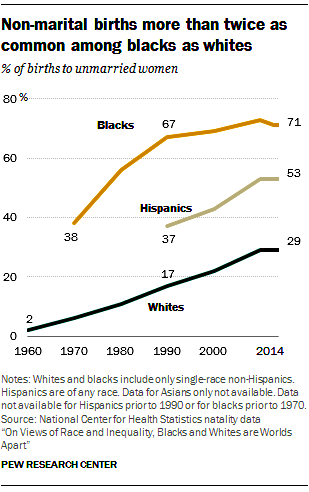
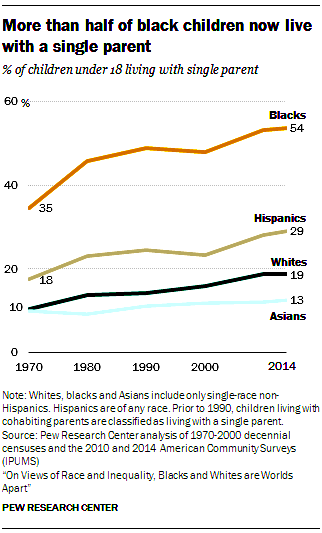
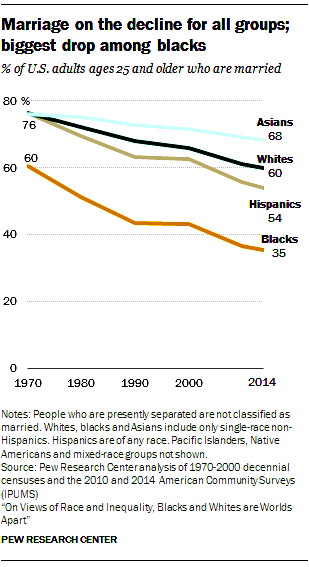
Black children are more than twice as likely as white children to be living with just one parent. More than half (54%) of Black children did so in 2014, compared with 19% of whites. This 35-percentage point difference marks a widening of the racial gap in children’s living arrangements. In 1970, 35% of Black children were living with only one parent, compared with 10% of white children (Figure \(\PageIndex{2b}\)).
The marriage rate has declined across racial and ethnic groups, but the drop has been particularly dramatic among Blacks. In 2014, some 35% of Black adults ages 25 and older were married, compared with 60% of whites. In 1970, this gap was considerably smaller: fully 60% of Blacks and 76% of whites were married at that time (Figure \(\PageIndex{2c}\)).
Structural barriers are often listed as the reason for the current trends in the African American family structure, specifically the decline in marriage rates. Imbalanced sex ratios have been cited as one of these barriers since the late nineteenth century, where Census data shows that in 1984, there were 99 Black males for every 100 Black females within the population. 2003 census data shows there are 91 Black males for every 100 females.
Criminal Justice System: Black Male Incarceration and Mortality
Let's also consider the link between the social institutions of family and the criminal justice system. Black male incarceration is often considered as one important explanation for the imbalanced sex ratios discussed earlier. Although Black males make up 6% of the population, they make up 50% of those who are incarcerated. This incarceration rate for Black males increased by a rate of more than four between the years of 1980 and 2003. The incarceration rate for African American males is 3,045 out of 100,000 compared to 465 per 100,000 white American males. In many areas around the country, the chance that Black males will be arrested and jailed at least once in their lifetime is extremely high. For Washington, D.C., this probability is between 80 and 90%.
Because Black males are incarcerated at six times the rate of white males, the skewed incarceration rates harm these Black males as well as their families and communities. Incarceration can affect former inmates and their future in society long after they leave prison. Those that have been incarcerated lose masculinity, as incarceration can affect a man's confirmation of his identity as a father and a breadwinner for the family. After being released from prison, efforts to reestablish or sustain connections and be active within the family are often unsuccessful. Incarceration can be damaging to familial ties and can have a negative effect on family relations and a man's sense of masculinity.
The New Jim Crow
The New Jim Crow: Mass Incarceration in the Age of Colorblindness is a book by Michelle Alexander, a civil rights litigator and legal scholar. Though the conventional point of view holds that systemic racial discrimination mostly ended with the civil rights movement reforms of the 1960s, Alexander posits that the U.S. criminal justice system uses the War on Drugs as a primary tool for enforcing traditional, as well as new modes of discrimination and oppression. These new modes of racism have led to not only the highest rate of incarceration in the world, but also a disproportionately large rate of imprisonment for African American men.
Alexander points out that mass incarceration is "a stunningly comprehensive and well-disguised system of racialized social control that functions in a manner strikingly similar to Jim Crow." The culmination of this social control is what Alexander calls a "racial caste system," a type of stratification wherein people of color are kept in an inferior position. Its emergence, she believes, is a direct response to the Civil Rights Movement. It is because of this that Alexander argues for issues with mass incarceration to be addressed as issues of racial justice and civil rights. To approach these matters as anything but would be to fortify this new racial caste. Thus, Alexander aims to mobilize the civil rights community to move the incarceration issue to the forefront of its agenda and to provide factual information, data, arguments and a point of reference for those interested in pursuing the issue. Her broader goal is the revamping of the prevailing mentality regarding human rights, equality and equal opportunities in America, to prevent future cyclical recurrence of what she sees as “racial control under changing disguise”. According to the author, what has been altered since the collapse of Jim Crow is not so much the basic structure of US society, as the language used to justify its affairs. She argues that when people of color are disproportionately labeled as “criminals”, this allows the unleashing of a whole range of legal discrimination measures in employment, housing, education, public benefits, voting rights, jury duty, and so on.
Alexander argues that the War on Drugs has a devastating impact on inner city African American communities, on a scale entirely out of proportion to the actual dimensions of criminal activity taking place within these communities. During the past three decades, the US prison population exploded from 300,000 to more than two million, with the majority of the increase due to drug convictions. This led to the US having the world's highest incarceration rate. The US incarceration rate is eight times that of Germany, a comparatively developed large democracy. Alexander claims that the US is unparalleled in the world in focusing enforcement of federal drug laws on racial and ethnic minorities. In the capital city of Washington, D.C. three out of four young African American males are expected to serve time in prison. While studies show that quantitatively Americans of different races consume illegal drugs at similar rates, in some states Black men have been sent to prison on drug charges at rates twenty to fifty times those of white men. The proportion of African American men with some sort of criminal record approaches 80% in some major US cities, and they become marginalized, part of what Alexander calls "a growing and permanent "undercaste".
Religion
The range of descriptions of African American religious experiences has traditionally fallen between the sacred and the profane. Particularly, for African American religious experiences the Black Church has been viewed as the most sacred aspect of Black religious communities. Subsequently, the Black Church has been described as the driving force behind the agenda of Black leaders during the Civil Rights Movement. However, it was not the Black Church that was the defining attribute of African American religious experiences during the middle of the twentieth century; rather, it was a particular idea that many held most sacred. The way African Americans testified to their own experience can be described as a prophetic testimony: the notion of prophecy was the force that inspired many leaders to use their day-to-day experiences as testimonies to start a movement that went beyond accommodation with the goal of transformation. In this context, prophetic testimony must be examined through the lens of political theology alongside history. The category of political theology helps to emphasize the deep connection between faith (a theological claim) and the exercise of faith (a political claim). In other words, political theology combines pragmatic functions of faith with the way it is practiced.
Paradox in the Black Church
Paradox in the Black Church
Black Church institutions have been acknowledged as the center for social justice movements within Black communities. Yet whether it is through examining the classical period of the Civil Rights Movement or a look at modern day religious leaders, there has not been one specific way that Black communities have sought to liberate their identities from a world that has not often recognized their humanity. Past examples include the crusades of organizations such as the Nation of Islam and the Pan-African Movement, while the Black Lives Matter Movement is a current example. This has led to numerous paradoxical responses to both civil rights and social movements from Black religious organizations. The paradox that occurs across the spectrum of Black Church institutions is deeply rooted in the historical context from which the traditions have developed.
During the period of enslavement in the United States slave masters recognized that religion could be used as a form of social control, especially in Southern states. Slave owners allowed slaves to hear biblical scripture, but only in so far as it reinforced the narrative that required their subordination to their masters. Many slave owners realized that controlled religion could be used to make their slaves docile and subordinate. Slaves were typically allowed to have their own services where either a white overseer or another slave gave a sermon based on the guidance of the master. In other words, officially sanctioned Black churches were under the supervision of white pastors who used religion as a way to reinforce their social and political agenda. To further limit any form of autonomy in Black churches, laws were created that prevented slaves from assembling together for “worship” or for any other purpose between sunrises and sunsets, even with a white master present in many Southern states. The only exception to these rules occurred when the slave masters took their slaves to an ordained white minister who regularly conducted services. Furthermore, the influence of white masters on many Black Churches created a religious benevolence between slave and slave master that helped to keep intact the moral order that served to justify both the institution of slavery and the treatment of slaves. Slaveholders had a religious imperative to make money and to have a comfortable living, as long as they were faithful to God. Masters were supposed to take great interest in the slave’s security because it would benefit both the slave and the owner. They also had the responsibility of teaching the enslaved Black Americans good behavior and morality.
They believed that religious instruction of the Black slaves would promote both their morality and their religion. Black churches became the ideal institution to realize the creation of a Christian interracial community. In these communities, slave owners would benevolently rule over their slaves, who were presumed to be satisfied with their positions in life. This form of social control had some success with slaves. Most did not subscribe to the benevolent master motif that was impressed upon them, but the combination of various methods of oppression left many slaves in desperate need of hope from some source. Many who chose to challenge the dominant narrative had hope in a political freedom that was possible only in the afterlife. The language of the slave spirituals makes proclamations such as: “I'm gonna wait upon the Lord till my change comes.” This represents one polarity in which the Black Church was pulled. Indeed, this ideology continued well beyond the period of African enslavement and into the Civil Rights Movement era.
Health
Health Inequality
A deep connection between the field of medicine and the overall treatment and perception of African American extends back to the founding of this country. Proponents used pseudo-scientific (discussed in Chapter 1.2 as racialized science) ideas about the "natural" inferiority of Blacks to justify racism and slavery. In turn, these same forces led to a health inequality—with poor care from the medical field and higher rates of serious health issues—that persist in the present. African Americans have also faced lasting barriers in gaining employment and professional recognition in the healthcare field.
From the origins and continuation of health inequality to the fight to gain access to professional medical treatment, African American health and healthcare in U.S. history are interrelated issues. African American physicians, dentists, and nurses along with Black medical schools and hospitals have done pioneering work. While traditionally receiving less attention than issues like voting, housing, and education, the African American fight for healthcare is an important component of the Black freedom struggle, and a key aspect for understanding the current state of Black Americans.
This section is licensed CC BY-NC. Attribution: Slavery to Liberation: The African American Experience (Encompass) (CC BY-NC 4.0)
African American Health in Early U.S. History
African American health is inextricably linked to slavery. Physician and scholar Rodney G. Hood argues that health disparities can be traced back to the period of slavery and the origins of racism, an effect he calls the "slave health deficit." The enslavement of millions of African Americans had severe and lasting health impacts, both during the period of slavery and after. The initial period of enslavement may have been the most lethal. Historians estimate that as many as 50% of Africans died before leaving the continent during capture, the forced march to slave holding areas, or waiting in pens. Somewhere between 15-20% died during the Middle Passage across the Atlantic from the fifteenth through the nineteenth century. The mortality rate varied by place of origin, conditions in captivity and on the ship, and the point of destination. As many as 675,000 died during capture, captivity, or transportation to this country. Of the 450,000 Africans who made it to the U.S., an additional 4.3% died in the period between arrival and sale, and as many as 25% perished during the "acclimation period" of their first eighteen months as they adjusted to new locations, climates, and diseases.
Enslaved individuals suffered from significant health problems. The Black infant and childhood mortality rate was double the rate for whites. Over half of all Black children were born severely underweight due to the poor treatment and lack of nutrition for pregnant slaves; many women miscarried or gave birth to stillborn babies. On average, Black mothers could nurse for only four months, compared to eight months for white babies. Early weaning, horrid living conditions, and lack of nutrition led to more than 50% of Black infants dying before the age of one.
The field of medicine both justified the poor treatment of African Americans and contributed to their health problems. Building on the writings of white intellectuals going back to at least the Greeks, leading American scientists and physicians categorized African Americans as biologically inferior and less intelligent, or even sub-human. By the early 1800s, proponents of slavery used this pseudo-scientific argument to justify slavery. Defenders of slavery further argued that Africans were more genetically predisposed to work in the fields than whites. Thomas Jefferson advocated this position in his influential Notes on the State of Virginia (1805). While he concluded that enslaved Africans were "inferior to the whites in the endowments both of body and mind," Jefferson argued that they possessed some qualities that made them genetically designed to labor, notably that they "seem to require less sleep" and were "more tolerant of heat." Physicians perpetuated the belief that Africans also had resistance or immunity to diseases like yellow fever.
The inequality in access to healthcare and the poor treatment by physicians in this period marked the beginning of a healthcare system based on racial discrimination. The view of African Americans as inferior and "less worthy" meant that few received proper medical care for curable afflictions. In some ways, free Blacks faced worse healthcare, with little access due to high rates of poverty and physicians who refused to treat Black patients. A two-tiered healthcare system—with greater access and treatment for whites—persisted for much of American history.
Medical Exploitation
Despite gains due to legislation, many African Americans remained distrustful of the government's involvement in healthcare. In the early twentieth century, the government funded forced sterilization programs in 32 states for tens of thousands of women, primarily people of color. Originating in the late nineteenth century, the eugenics movement spread in the U.S. starting in the 1900s. Eugenics was based on the concept that selective breeding should be encouraged, with government involvement, to improve society. Supported by funding from leading organizations like the Carnegie and Rockefeller foundations, scientists from top universities carried out pseudo-scientific research that demonstrated supposed negative genetic traits of certain groups that should not be allowed to reproduce: the mentally ill or disabled, those deemed sexually deviant, criminals, immigrants, the indigent, and minorities. Some doctors actively engaged in eugenicide, killing patients or willfully neglecting them—often newborns—until they died.
Forced sterilization became the most mainstream manifestation of eugenics, with states adopting forced sterilization laws in the first decade of the twentieth century. Although masked as progressive reform (to produce the most superior citizens and to reduce government spending on providing for the "unworthy") and supported by public health advocates, scientists, physicians, and politicians, forced sterilization was a product of racism and xenophobia (xenophobia was discussed earlier in Chapter 3.5). In many ways, proponents promoted forced sterilization similar to the ways they advocated residential segregation (i.e., African Americans should be kept out of white neighborhoods to prevent the spread of disease) or anti-miscegenation (i.e., interracial marriage and children would produce "inferior," mixed race children, damaging to white purity). The Nazis partially modeled their own policies of sterilization and eugenicide in the 1930s and 1940s on American practices.
Eighteen Southern states adopted sterilization laws and often used them to target African American women. In 1964, Mississippi Freedom Democratic Party leader and voting rights advocate Fannie Lou Hamer spoke of her own experience. In 1961, Hamer underwent surgery in Mississippi for a uterine tumor. During surgery, and without her consent, the operating physician performed an unnecessary hysterectomy. Hamer highlighted the commonality of the procedure, which she dubbed a "Mississippi appendectomy," and estimated that physicians at the hospital, without consent and with no medical need, sterilized approximately 60% of Black female patients.
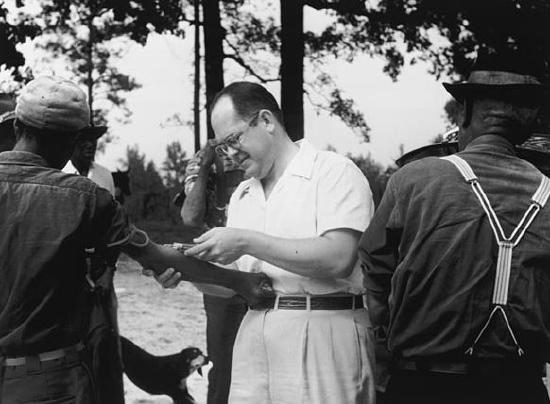
The Black Panther Party's health program further reflected the distrust of medical institutions. As detailed earlier, physicians used enslaved African Americans for medical experiments. Hospitals and prisons continued this practice after slavery ended, and medical colleges stole African American cadavers for student training. Perhaps the most famous example of medical exploitation was the Tuskegee Experiment, started by the U.S. Public Health Service in 1932. The program recruited 600 Black men—399 with syphilis, and 201 not infected—for a study on the effects of the disease. Administrators promised free medical treatment for participants. However, physicians did not inform the men of the purpose of the study and did not treat the individuals who had syphilis, even after penicillin was discovered as a cure in 1947. In 1972, the Associated Press reported on the story, leading to a public outcry and investigations. Recent research has demonstrated that the history of medical exploitation, particularly the Tuskegee Experiment, has led African Americans to be more distrustful of doctors and less likely to use healthcare services, contributing to the higher mortality rare.
Continuing Health Inequality
While the immediate years after integration saw some health gains for African Americans, particularly for those who previously had no access at all, improvements largely stagnated after 1975. Starting in the 1980s, Black mortality began to increase again, and African American life expectancy declined. With white flight to the suburbs, Black residents were increasingly concentrated in urban cores with underfunded and lower-quality healthcare.
In the face of continued health disparity, African American groups again provided their own medical services. Leonidas H. Berry founded an organization named the Flying Black Medics. Sponsored by the Methodist Episcopal Church and local community groups, the group began flights in 1970 from Chicago to Cairo, Illinois, providing free medical care and supplies to poor African Americans. In the late 1960s, the Black Panther Party became involved in healthcare. The national organization required all chapters to provide health clinics due to continued health discrimination and inequality. The Panthers also launched a sickle cell anemia awareness campaign, providing education and free screening for the disease, which the organization felt was understudied and underfunded as it disproportionately affected African Americans.
In the 1980s, the increase in the Black mortality rate also corresponded with the decreased funding for hospitals that predominantly served the African American community. State aid declined dramatically, particularly with the economic recession. The number of Black hospitals rapidly plummeted as a result. From 1961 to 1988, forty-nine Black hospitals closed, including Chicago's Provident Hospital, the first Black-operated hospital in the country.
Contemporary Health Disparities Experienced by African Americans
Health inequality persists in the U.S. The Centers for Disease Control (CDC) and Prevention found that African Americans have a significantly shorter life expectancy (75.1 years) than whites (78.7). African Americans suffer from higher rates of illness and health problems; the CDC estimates that 13.6% of African Americans are in poor health compared to 9.5% of whites. The overall mortality rate has dropped for all races in the past two decades, driven by declining deaths from cancer, heart attacks, and strokes. However, African Americans still have a mortality rate 16% higher than whites (down from 33% in 1999), and are more likely to die at every age. The discrepancy is particularly notable in infant mortality—a rate of 10.93 per 1,000 for Blacks and 4.89 per 1,000 for whites—and in maternal deaths with a rate of 43.5 Black deaths per 100,000 live births compared to 12.7 white deaths per 100,000 live births. The mortality rates for African American males are also typically higher than they are for African American females. This is another explanation for the imbalanced sex ratios mentioned earlier in the discussion on the African American Family. Between 1980 and 2003, 4,744 to 27,141 more African American males died annually than African American females. This higher mortality rate helps to explain the low marriage rates for many African American females who cannot find Black partners.
According to the Centers for Disease Control and Prevention (CDC), the following were the leading causes of death of Black men in 2017:
| Non-Hispanic Black, Male, All ages | Percent |
|---|---|
| 1) Heart disease | 23.7% |
| 2) Cancer | 20.2% |
| 3) Unintentional injuries | 7.9% |
| 4) Homicide | 5.0% |
| 5) Stroke | 4.9% |
| 6) Diabetes | 4.3% |
| 7) Chronic lower respiratory diseases | 3.2% |
| 8) Kidney disease | 2.6% |
| 9) Septicemia | 1.7% |
| 10) Hypertension | 1.6% |
For young Black men between the ages of 15 and 44, the number one cause of death in 2017 was homicide. Strikingly, the number six cause of death for Black men in this age range is police violence.
According to the Centers for Disease Control and Prevention (CDC), the following were the leading causes of death of Black women in 2016:
| Non-Hispanic Black, Female, All ages | Percent |
|---|---|
| 1) Heart disease | 23.1% |
| 2) Cancer | 21.8% |
| 3) Stroke | 6.4% |
| 4) Diabetes | 4.5% |
| 5) Alzheimer’s disease | 3.9% |
| 6) Unintentional injuries | 3.6% |
| 7) Chronic lower respiratory diseases | 3.4% |
| 8) Kidney disease | 3.1% |
| 9) Septicemia | 2.3% |
| 10) Hypertension | 2.0% |
Health inequality reflects multiple factors: higher rates of unemployment, obesity, and poverty as well as lower rates of home ownership, education, and wealth. African Americans also continue to have less access to healthcare: 11.2% under the age of 65 do not have healthcare, compared to 7.5% of whites. Researchers have also demonstrated that racial discrimination, including from the healthcare system itself, also negatively impacts health. Inequality continues in the medical profession, too. While making up 12% of the overall population, less than 6% of physicians and surgeons are Black.
The roots of health inequality date back to the beginning of this country. Treated as racially inferior, neglected or excluded by white healthcare systems and as the victims of systematic and institutionalized racism and segregation, African Americans have suffered higher rates of disease and mortality than white Americans throughout this country's history. African Americans have fought for increased access; provided care for themselves in various forms, from enslaved midwives to Black hospitals; and made important contributions to the medical field. However, the historical vestiges of a two-tiered healthcare system remain as deeply entrenched as other aspects of structural/system racism (defined in Chapter 4.4).
Education
Increasingly, a college degree is the key to financial well-being, while the value of a high school diploma has diminished markedly over time. Since the 1960s, rates of college graduation have increased significantly for all major racial and ethnic groups, though large gaps persist as Blacks still trail whites in college completion, according to the 2016 Pew Research Center report (Figure \(\PageIndex{8}\)).
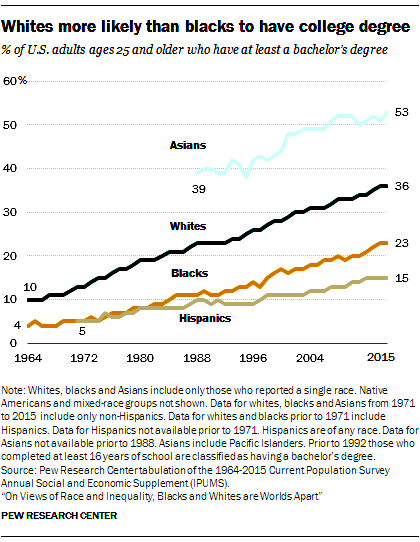
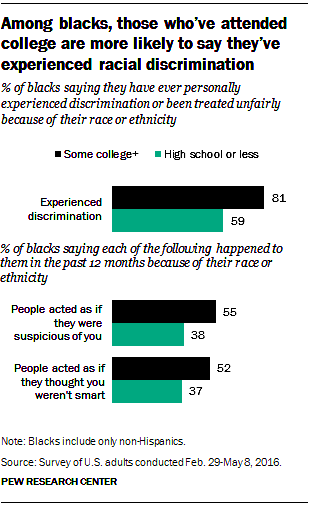
The 2016 Pew Research Center analysis of U.S. Census Bureau data shows that while the income gap between Black and white college-degree earners is narrower than those with less education, it still remains significant. The median adjusted household income among Black householders with at least a bachelor’s degree was $82,300 in 2014, compared with $106,600 among white householders with the same level of education. Put another way, among households whose head is college-educated, Black households earn 77% what white households do (Figure \(\PageIndex{9}\)).
Education alone also does not close unemployment gaps between Blacks and whites. The unemployment rate for Blacks in 2015 was roughly double that of whites across all educational categories, according to the 2016 Pew Research Center’s analysis of Census Bureau data.
Economics
Black households have only 10 cents in wealth for every dollar held by white households (Pew Research Center, 2017). In 2016, the median wealth of non-Hispanic white households was $171,000. That’s 10 times the wealth of Black households ($17,100) – which reflects a larger gap than in 2007. The Great Recession of 2007-2009 triggered a stark decline in wealth for U.S. families and further widened the already large wealth gap between white and Black households. Yet the Black-to-white wealth gap has evolved differently for families at different income levels, according to a Pew Research Center analysis of Federal Reserve data. The wealth gap increased between middle-income Black and white families, but shrank between lower-income Black and white families from 2007 to 2016. Much of the reduction in the wealth gap among lower-income families was driven by a sharp decrease in wealth for whites Figure \(\PageIndex{10}\).
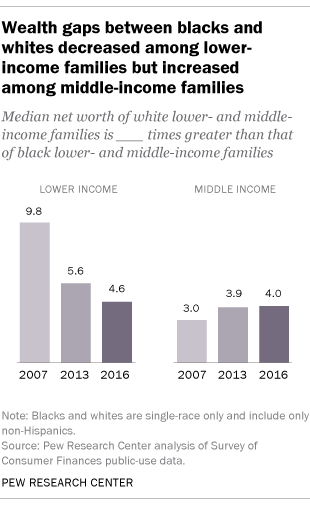
Blacks are more than twice as likely as whites to live in poverty (Income and Poverty in the United States: 2014). In 2014, about a quarter (26%) of Blacks were poor, compared with 10% of whites. The Black-white poverty gap has narrowed somewhat since the mid-1970s, when 30% of Blacks were living below the poverty line – a proportion nearly four times the share of whites living in poverty (8%).
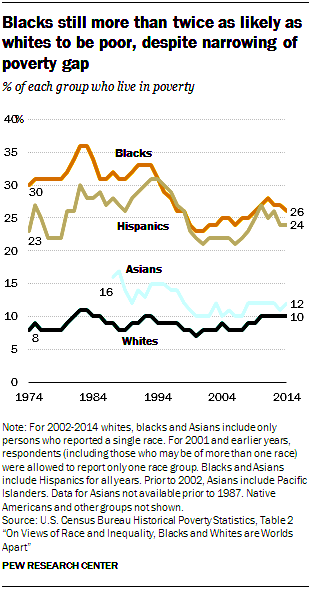 Figure \(\PageIndex{11}\): Blacks are still more than twice as likely as Whites to be poor, despite narrowing of poverty gap. (Used with permission; On Views of Race and Inequality, Blacks and whites Are Worlds Apart. Pew Research Center, Washington, D.C. (2016))
Figure \(\PageIndex{11}\): Blacks are still more than twice as likely as Whites to be poor, despite narrowing of poverty gap. (Used with permission; On Views of Race and Inequality, Blacks and whites Are Worlds Apart. Pew Research Center, Washington, D.C. (2016))
Politics
Many Blacks view political representation as a potential catalyst for increased racial equality, according to a 2016 Pew Research Center survey. Roughly four-in-ten Black adults (38%) said that working to get more Black people elected to office would be a very effective tactic for groups striving to help Blacks achieve equality.
Following Reconstruction till 1900, large numbers of Black Americans were elected to political office at the local, state and national levels. These elected officials included: Hiram Revels, first Black U.S. Senator (who was also a member of the Lumbee Nation) and Frederick Douglass, appointed President of the Freedman's Saving Bank and diplomat to the Dominican Republic. As discussed in Chapter 7.2, the Jim Crow era and backlash against the Black middle class all but contributed to the absence of Black elected officials for the better part of the 20th century. Only 11 Black senators have been elected in all of U.S. history, with the most recent being Reverand Raphael Warnock, who won a highly contested runoff in Georgia in 2021. Barack Obama, the most famous of these was elected as the first Black President. Shirley Chisholm was the first African American to run for President in 1972; in her bid to run on the Democratic Party ticket, she announced, “I am not the candidate of Black America, although I am Black and proud. I am not the candidate of the women’s movement in this country, although I am a woman, and equally proud of that... I am the candidate of the people of America.”
Voting
In 1870, the 15th Amendment was ratified, guaranteeing African American (men) the right to vote; however, challenges to this right included the poll tax, the grandfather clause, and literacy tests which disenfranchised countless Black voters during the Jim Crow era encompassing most of the 20th century. The 19th Amendment was passed in 1920, guaranteeing suffrage for all women, including Black women. Yet, the struggle to vote continued. The Civil Rights Movement championed voting rights in campaigns such Freedom Summer (Mississippi) and the Selma to Montgomery (Alabama) March, registering thousands of Black voters. Fannie Lou Hamer, an organizer of Freedom Summer and co-founder of the Mississippi Freedom Democratic Party, went to the 1964 Democratic Party Convention, attempting to be part of the official delegation, gave a blistering speech with details about voter registration suppression - which was later televised nationally and gained further support for the voting rights for Black Americans. President Lyndon Johnson signed into law the Voting Rights Act of 1965, prohibiting racial discrimination in voting. While Congress amended the Act to extend its enforcement, in the last decade, significant challenges to the enforcement have been granted by the U.S. Supreme Court, thereby negating the strength of the Voting Rights Act. Additionally, Southern states, such as Florida, Alabama, Kentucky, Mississippi, Tennessee, and Virginia, deny convicted felons the right to ever vote - even after they have served their sentence, a policy which disproportionately impacts the Black population which has higher incarceration rates than other race-ethnic groups. According to the Sentencing Project (2016), one in 13 African Americans of voting age is disenfranchised, which is four times greater than non-African Americans voters. Further, over 7.4 percent of the adult African American population is disenfranchised compared to 1.8 percent of the non-African American population (Sentencing Project, 2016). In Florida, Kentucky, Tennessee, and Virginia, more than 1 in 5 African Ameicans is a disenfranchised voter due to a felony conviction. With so many disenfrancised voters, the struggle for voting rights for Black voters is far from over. Yet, through the efforts of voting rights activists such as Stacey Abrams, who co-founded the New Georgia Project in 2014 and registered more than 500,000 new voters, the state of Georgia shifted to a predominantly Democratic state in 2020, helping the Biden-Harris ticket to clench the 2020 Presidential election.
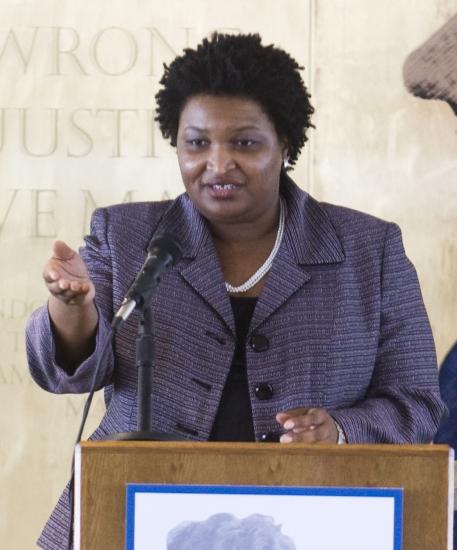
Contributors and Attributions
Content on this page has multiple licenses. Everything is CC BY-SA other than Paradox in the Black Church and Health Inequality which are CC BY-NC.
- Johnson, Shaheen. (Long Beach City College)
- Hund, Janét. (Long Beach City College)
- Slavery to Liberation: The African American Experience (Encompass) (CC BY-NC 4.0) (Contributed to: Paradox in the Black Church and Health Inequality)
- African-American Family Structure (Wikipedia) (CC BY-SA 3.0)
- The New Jim Crow (Wikipedia) (CC BY-SA 3.0)
Works Cited
- Anderson, M. (2016, July 16). Blacks with college experience more likely to say they faced discrimination. Pew Research Center.
- Billingsley, A. (1992). Climbing Jacob's Ladder. New York, NY: Simon & Schuster.
- Brown, T. & Patterson, E. (2019). Wounds from incarceration that never heal. The New Republic.
- Byrd, W. M. & Clayton, L.A. (1992). An American health dilemma: a history of Blacks in the health system. Journal of the National Medical Association, 84(2), 189.
- Centers for Disease Control and Prevention. (2020). LastStats - Health of Black or African American population.
- Daniel P.M. (1965). The Negro Family: The Case for National Action, Washington, D.C., Office of Policy Planning and Research, U.S. Department of Labor.
- Digital History. (2016). What was life like under slavery. Digital History.
- Dixon, P. (2009). Marriage among African Americans: What does the research reveal? Journal of African American Studies. 13(1): 29–46.
- Dyer, W.M. (2005). Prison fathers, and identity: A theory of how incarceration affects men's paternal identity. Fathering: A Journal of Theory, Research, and Practice About Men as Fathers. 3(3): 201–219.
- Fogel, R.W. (1994). Without Consent or Contract: The Rise and Fall of American Slavery. New York, NY: WW Norton & Company.
- Gates, Jr., H.L. (2014). How many slaves landed in the U.S. The Root.
- Paul C. Glick, ed. by Harriette Pipes McAdoo (1997). Black families (3rd ed.). Thousand Oaks, Calif. [u.a.]: Sage. p. 119.
- Herbert C.C. (2007). African American Slave Medicine: Herbal and Non-Herbal Treatments. Lanham, MD: Lexington Books.
- Heron, M. (2018). Deaths: leading causes for 2016. National Vital Statistics Report, US Department of Health and Human Services.
- Hershberg, T. (1971). Free Blacks in antebellum Philadelphia: A study of ex-slaves, freeborn, and socioeconomic decline. Journal of Social History, 183-209.
- Hood, R.G. (2001). The" slave health deficit:" The case for reparations to bring health parity to African Americans. Journal of the National Medical Association, 93(1),
- Klein, H.S., Engerman, S.L., Haines, R., & Shlomowitz, R. (2001). Transoceanic mortality: The slave trade in comparative perspective. The William and Mary Quarterly, 58(1), 93-118.
- Kochhar, R. & Cilluffo. A. (2017). How wealth inequality has changed in the U.S. since the great recession, by race, ethnicity and income. Pew Research Center.
- McAdoo, P. (1997). Black Families. 3rd ed.. Thousand Oaks, CA.
- Mintz, S. (2013). Childhood and transatlantic slavery. Children & Youth in History.
- Moynihan, Daniel P. The Negro Family: The Case for National Action, Washington, D.C., Office of Policy Planning and Research, U.S. Department of Labor, 1965.
- Morgan, S.,McDaniel, A., Miller, A.T., & Preston, S.H. (1993). Racial differences in household and family structure at the turn of the century. American Journal of Sociology. 98(4): 799–828.
- Pew Research Center. (2016). On views of race and inequality, Blacks and whites are worlds apart.

